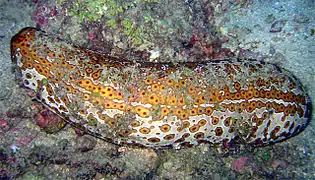| Bohadschia argus | |
|---|---|
 | |
| Scientific classification | |
| Domain: | Eukaryota |
| Kingdom: | Animalia |
| Phylum: | Echinodermata |
| Class: | Holothuroidea |
| Order: | Holothuriida |
| Family: | Holothuriidae |
| Genus: | Bohadschia |
| Species: | B. argus |
| Binomial name | |
| Bohadschia argus | |
| Synonyms | |
| |
Bohadschia argus, the leopard sea cucumber, leopardfish, or tigerfish, is a species of marine invertebrate in the family Holothuriidae.
Description
_on_Bohadschia_argus_(Sea_cucumber).jpg.webp)
Bohadschia argus is sausage-shaped with a smooth, tough, leathery skin and can grow to 2 feet (0.61 m) in length. It is a greyish-brown colour, paler below, with distinctive dark eye-spots There are several rows of tube feet on the underside. Surrounding the mouth at the anterior end is a ring of paddle-shaped, black tentacles fringed with white. The anus, at the posterior end, has Cuvierian tubules situated at its base which are readily ejected as sticky threads if the animal is disturbed or handled. These contain toxins which deter predators and are irritating to human skin.[3][4]
Bohadschia argus appears to be able to hybridize with Bohadschia vitiensis.[5]
Distribution and habitat
Bohadschia argus is found in the eastern Indian Ocean and the western Pacific Ocean.[1] It is found on coral reefs and on exposed, sandy areas of the seabed [3] at depths of between 10 feet (3.0 m) and 120 feet (37 m).[6]
Biology
Bohadschia argus is an omnivore. As it moves across the seabed, it sweeps sand grains and detritus into its mouth using its sticky tentacles. It obtains some nourishment from the biofilm that coats the grains.[4]
Ecology
Fish of the species Carapus mourlani are sometimes found living in the coelomic cavity of Bohadschia argus; the fish enter through the anus, either going in head first or more frequently tail first. In a study in the Banda Islands in the South Moluccan Sea, 15 individual fish were found to be inhabiting the body of one sea cucumber 40 centimetres (16 in) in length.[7]
The small emperor shrimp (Periclimenes imperator) is often associated with Bohadschia argus and may help keep it clear of ectoparasites.
Uses
A new triterpene glycoside, Arguside A, has been extracted from the tissues of Bohadschia argus. This compound appears to exhibit cytotoxicity against several different types of human tumour cells.[8]
References
- 1 2 Conand, C.; Gamboa, R.; Purcell, S. (2013). "Bohadschia argus". IUCN Red List of Threatened Species. 2013: e.T180541A1645352. doi:10.2305/IUCN.UK.2013-1.RLTS.T180541A1645352.en. Retrieved 29 January 2023.
- ↑ Paulay, Gustav (2010). "Bohadschia argus Jaeger, 1833". WoRMS. World Register of Marine Species. Retrieved 2012-01-19.
- 1 2 Bohadschia argus North Australian Sea Cucumbers. Retrieved 2012-01-18.
- 1 2 Bohadschia argus DiveGallery. Retrieved 2012-01-18.
- ↑ Kim, Sun W.; Kerr, Alexander M. & Paulay, Gustav (2013). "Colour, confusion, and crossing: resolution of species problems in Bohadschia (Echinodermata: Holothuroidea)". Zoological Journal of the Linnean Society. 168 (1): 81–97. doi:10.1111/zoj.12026.
- ↑ Leopard sea cucumber Florent’s guide to the tropical reefs. Retrieved 2012-01-18.
- ↑ Meyer-Rochow, VB (1977). "Comparison between 15 Caropus mourlani in a single holothurian and 19 C. mourlani from starfish". Copeia. 1977 (3): 582–584. doi:10.2307/1443286. JSTOR 1443286.
- ↑ Liu, Bao-Shu; et al. (2007). "Arguside A: A New Cytotoxic Triterpene Glycoside from the Sea Cucumber Bohadschia argus". Chemistry & Biodiversity. 4 (12): 2845–2851. doi:10.1002/cbdv.200790234. PMID 18081095.
External links
- Photos of Bohadschia argus on Sealife Collection
